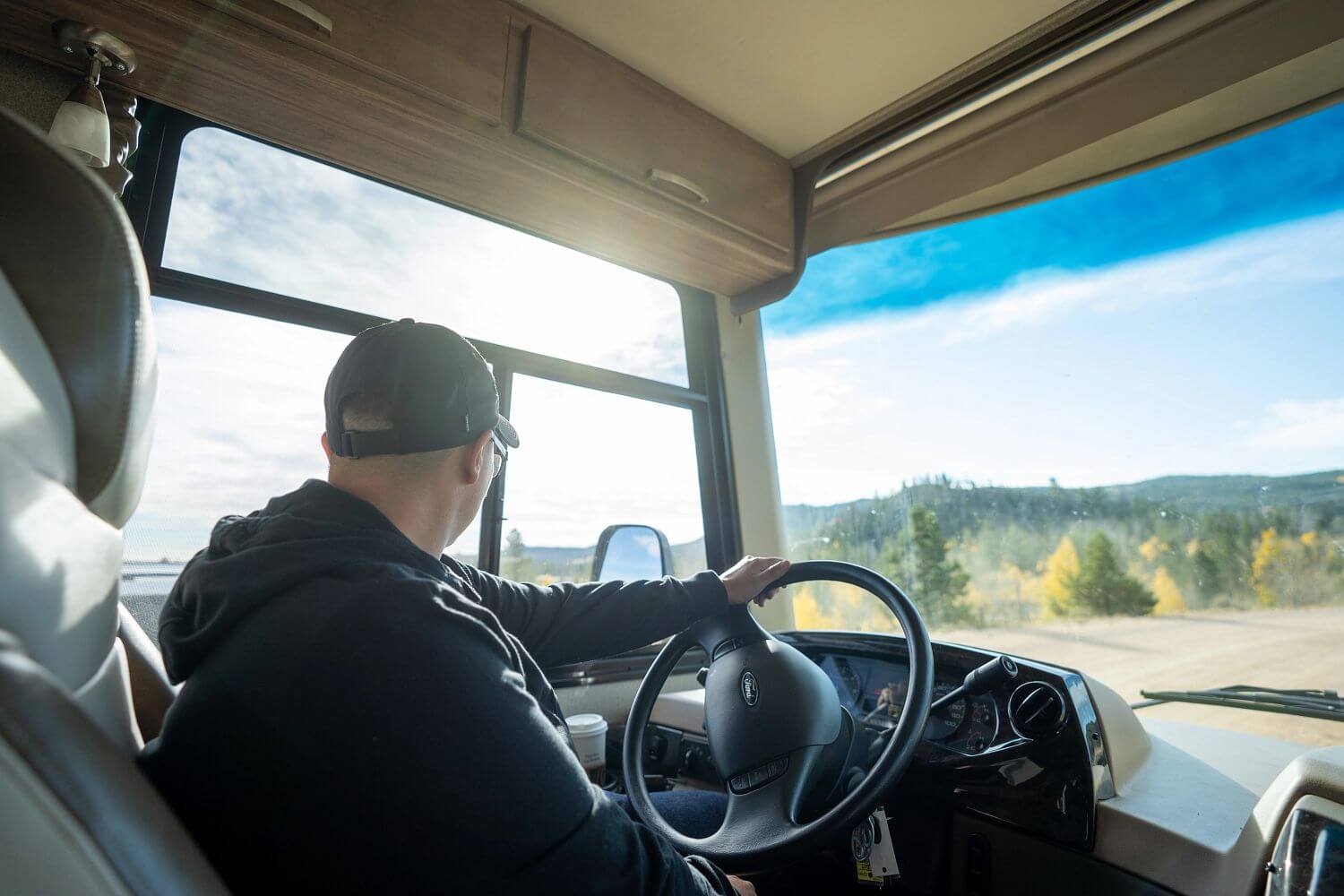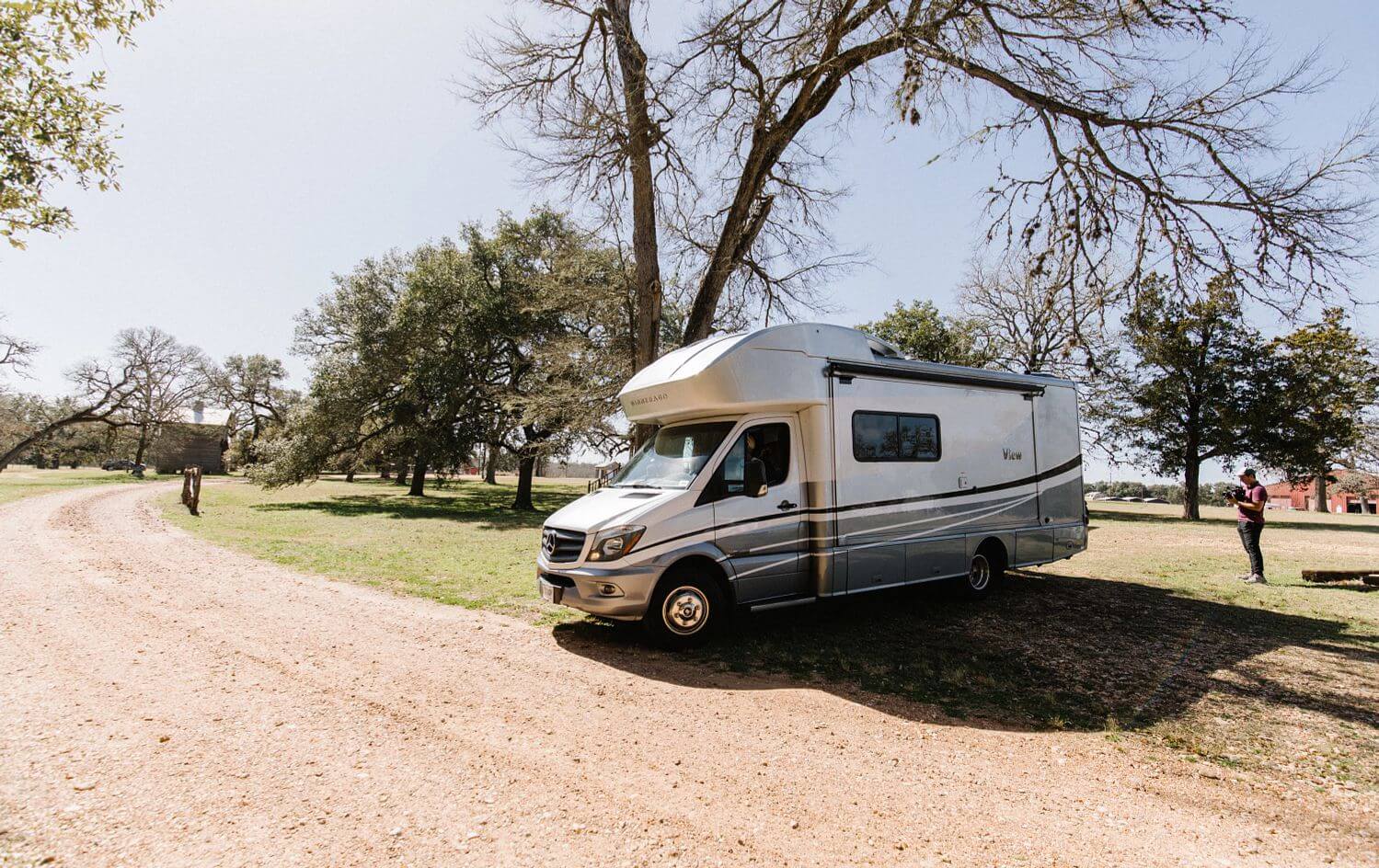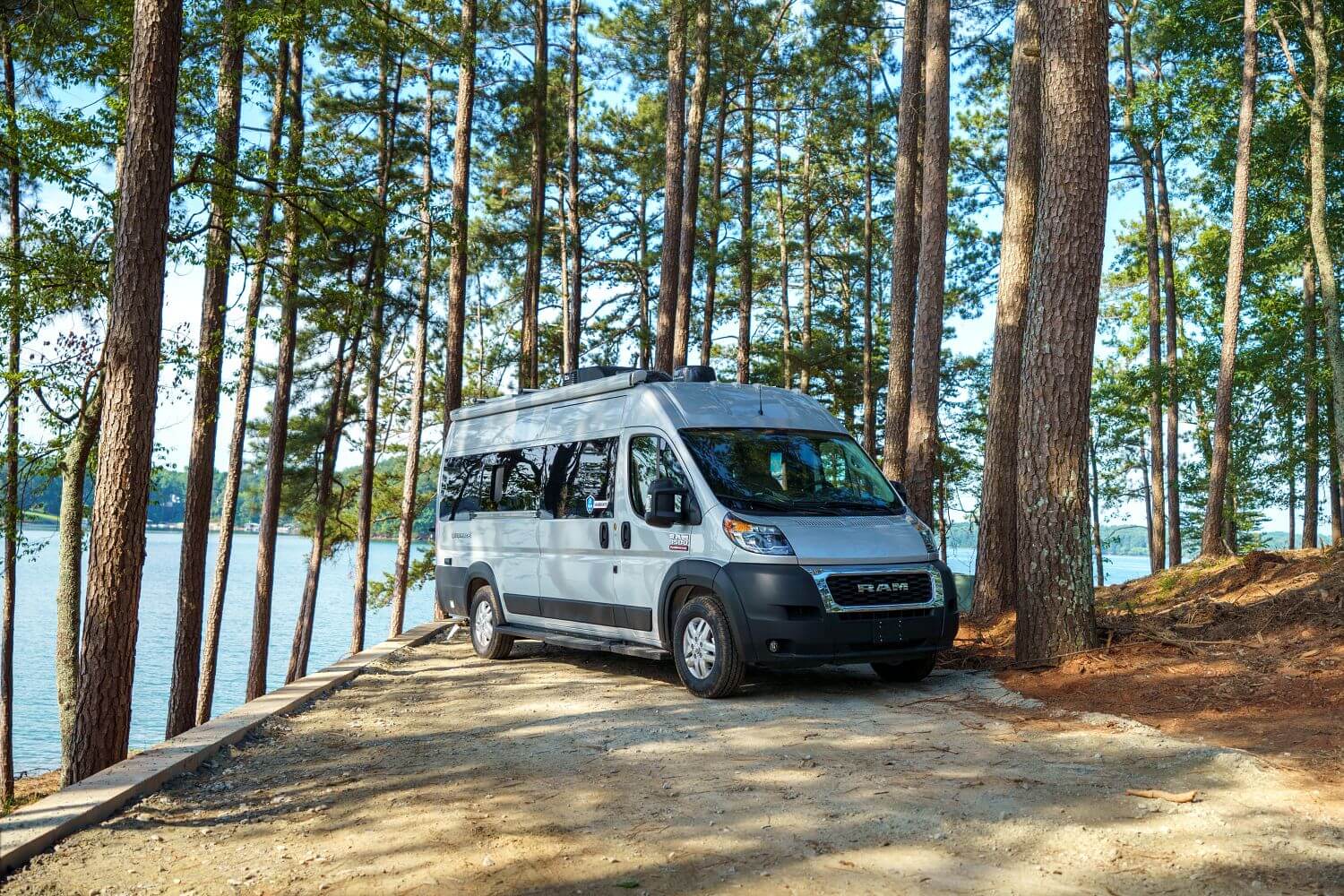Many would-be RV campers worry about driving a motorhome safely. But it’s not as difficult as you might think. Unless the model is especially long or heavy, a special license to drive an RV isn’t required. Most learn quickly with a little practice. Still, with the many motorhome types out there, it’s natural to wonder which is the easiest RV to drive.
Does the following sound familiar?
I love the idea of RV travel, but I’ve never driven anything bigger than a sedan.
If so, let’s help ease your hesitations as we evaluate how you can find an easy-to-drive RV.
Table of Contents
ToggleAre RVs Hard to Drive?

Experienced RVers will tell you driving is easy—but certain RV types take more getting used to than others. Longer, heavier motorhomes generally come with the biggest learning curve for RV beginners. While towable RVs have special considerations compared to motorhomes, our focus today is on RVs with a steering wheel—Class A, B, C, and B+ motorhomes.
The following concepts apply to almost all motorhomes:
- Wider turn radius
- Slower acceleration
- Increased stopping distance
In short, drivers must account for a wider turning radius and concepts like tail swing—when the rear of their motorhome swings out and away from the direction of their turn. They must also understand that it takes longer to accelerate when getting up to a safe speed to merge with the traffic flow, and they must look further down the road to prepare for stopped or slowed traffic.
A longer motorhome will have a bigger learning curve because there can be as much as 30 to 40 feet of RV behind you. But, most compact campers are easy to learn and fairly intuitive to drive—the Freedom Elite 19HE Class C and the Freedom Traveler A24 Class A are great examples. You can even consider renting an RV to gain experience before buying.
RV Pro Tip: Regardless of the make and model you drive, all RVers should follow these RV driving safety tips.
What Is the Easiest RV to Drive?

Class B RVs are the easiest models to drive, especially for new RV campers. These mini motorhomes aren’t much longer than a pickup truck and can easily maneuver into parking spaces and gas stations. Choose a class B camper if you’re looking for the easiest transition into RV driving.
However, debating the driveability of class A vs class C motorhomes will result in the realization that they don’t require much more skill and expertise. Their added length and weight are the biggest factors, requiring more braking time, wider turns, and advanced route planning.
That said, RV manufacturers have increasingly innovated with small Class C and A RVs to appeal to those who don’t want to feel like they’re driving a tour bus on every trip. You can compare those newer models to their Class B counterparts using these links:
- Find the Perfect Small Class A RV
- Best Class C RVs Under 25 Feet
And when you ask experienced RV owners, many say that Class C RVs are easier to drive than Class A motorhomes because the cab feels more like a large truck than a bus. However, larger motorhomes also have added safety features like rear and side view cameras to eliminate blind spots.
Even for new RVers, these considerations are easy to overcome, especially when driving on the highway. It can feel different when you exit the highway and find yourself on crowded city streets, but comfort comes with practice. Also, the more you plan your routes, the easier your RV navigation will be.
What Type of RV Is the Easiest to Drive?
Let’s look deeper at the considerations for driving each RV type.
Class A RVs

Class A motorhomes are typically 26 to 45 feet long and 8 feet wide, making them the largest motorized RVs. Most Class A motorhomes feature abundant underbelly storage, meaning the cockpit is more elevated than others.
This provides excellent visibility, helping drivers recognize road hazards with enough time to react safely. Learn more about Class A motorhome sizes and how to choose the right one for your travel lifestyle.
Class B Camper Vans

Class B motorhomes are easy to drive and fit standard amenities into a compact package. They’re typically 17 to 23 feet long, 7 feet wide, and 9 to 11 feet tall. Class B RVs don’t usually have to worry about the required RV height clearance of other motorhome types.
Also referred to as a camper van, Class B motorhomes drive a lot like a standard van or truck. Drivers sit higher than in a small sedan, but there’s not much difference between driving a commuter vehicle. Discover our picks for the best Class B RV in 2025.
Class B Plus, Class C, and Super C RVs

Class C, including Super C motorhomes, range from roughly 21 to 41 feet long and are usually 7.5 to 8 feet wide. Including many of the hybrid Class B+ campers, these floor plans are generally recognized by the cabover bed that provides extra sleeping capacity, making them excellent for family RV camping.
The cockpit sits lower than the cockpit of a class A motorhome, making them feel like driving a large truck but requiring extra braking distance and wider turns.
Class B Plus RVs (and some small Class C campers) are built on cutaway or cab chassis platforms from auto manufacturers like RAM, Ford, and Mercedes-Benz. Class C and Super C motorhomes are mostly built on popular Ford and Chevy truck chassis, with Super C models being built on heavier-duty chassis with more powerful engines and larger basement storage areas.
Easiest to Drive RV Options
While many motorhomes offer easy road navigation, let’s explore three of our favorites in each main category:
Easiest Small RV to Drive: Eddie Bauer 19EB
Specs
- Length: 19’8”
- Chassis: Mercedes-Benz® Sprinter 2500 AWD
- GVWR: 9,050 pounds
- Sleeping Capacity: Up to 2
The Mercedes chassis offers many safety and convenience features, making the Thor Eddie Bauer 19EB one of the easiest small RVs to drive in 2025. Simple things like remote heated exterior mirrors ensure optimal visibility in inclement weather. More sophisticated systems like Blind Spot Assist and Active Lane Keeping Assist enhance your safety as a new RV driver.
You might overlook the added convenience of a tilting and telescoping steering wheel as well, allowing for optimal customization if you and your partner split the driving duties. Plus, off-road tires improve this small camper’s ability to travel off the beaten path safely.
Easiest Class C RV to Drive: Freedom Elite 19HE
Specs
- Length: 20’5”
- Chassis: Ford® E-Series
- GVWR: 11,500 pounds
- Sleeping Capacity: Up to 4
Coming in at just over 20 feet, the Thor Freedom Elite 19HE is more compact than some camper vans. Combine that short frame with the easy-to-drive features of the Ford truck chassis, and you will get one of the easiest Class C RVs to drive. It has a unique floor plan for couples or solo campers.
A bonus feature like the Touch N’ Go Control panel makes this cabover camper easy to drive and easy to use once you’re in camp, too. It gives you one touchscreen display for rearview monitoring and audio controls while driving and a convenient place to check holding tank levels and power your generator on and off when parked.
Easiest Class A RV to Drive: Freedom Traveler A24
Specs
- Length: 25’8”
- Chassis: Ford® F-53
- GVWR: 12,500 pounds
- Sleeping Capacity: Up to 4
Class A RVs under 30 feet are rare, but this 26-foot motorhome redefines the term “compact Class A.” The Thor Freedom Traveler A24 also offers a unique floor plan typically only seen in Class B Plus campers—the rear twin beds with an optional king bed conversion. This feature makes it perfect for couples who prefer separate sleeping areas or traveling with friends.
When driving, a 10” touchscreen dash display makes it easy to dial up your favorite music or audiobooks to pass the time. Heated exterior mirrors, backup and side view cameras, and camera controls on the steering wheel all contribute to the easy-driving capability of this Thor motorhome.
Which Motorhome Gets The Best Fuel Economy?

Easy RV driving includes how frequently you must fill your tank. Certain motorhome classes are more nimble in navigating gas stations than others. Motorhome fuel economy varies by make, model, and cargo weight, so the figures below represent averages.
- Class A: 6-10 miles per gallon (MPG)
- Class B: 18-22 MPG
- Class B+, Class C, and Super C: 8-15 MPG
Factor in fuel tank capacity when calculating the range you’ll enjoy between gas stops. Though Class A RVs are less fuel-efficient than van campers, some can travel further between gas stops due to larger fuel tanks.
How Do You Find The Right RV for You?
Your RV selection should consider many factors, such as floorplan, sleeping space, tank capacities, fuel economy, etc. Choose a shorter, lighter motorhome if easy driving is your primary concern.
If you won’t drive your motorhome much (like if you move your RV a few times a year), driving and fuel economy aren’t as concerning as prioritizing the comforts you want in a coach.
Concerns about the easiest RV to drive shouldn’t stop you from enjoying the health benefits of RV traveling. Driving is just a small part of any RV journey, and the right motorhome will bring a new level of comfort and luxury to your next road trip.
If you’re already an RV owner looking for an easy-to-drive RV compared to your current one, explore RV trade-in options.
For those looking for your first RV, here are a few additional resources:
- Best RV for Beginners
- Best Used Motorhomes
- Favorite Mercedes Camper Van
- Benefits of Exclusive RV Brands
- Do You Need an AWD RV?
- Best Mercedes Class C RV
What questions do you have about driving an RV? Share them in the comments below!
Author
-

Tucker Ballister is our Content Strategist. He grew up RV camping in a Fleetwood Bounder with his parents and has lived and camped in two motorhomes and two travel trailers of his own. His current RV is a 2025 Forest River Campsite Ultra 26BW, which he loves taking on adventures with his wonderful partner and furry companion from their home base in Western North Carolina. Check out his adventures, gear reviews, and outdoor advice at thebackpackguide.com.
View all posts









I have a 450 lb power chair. I will be living in the rv. I have mold illness. I need an rv that does not leak. I also have mcs. So need the rv to be off gassed. I have a low ss budget.
Hi Charlene!
I’d recommend contacting a sales representative at your local dealership. Here’s where you can find the Camping World closest to you: https://rv.campingworld.com/locations
Hi looking at a hino liesse motorhome 5.4 ltr any problems?
We are looking for a smaller van camper that you could walk in cook in as a shower in the bathroom refrigerator air condition we do not camper. We want to be able to just drive a camping van nothing that we have to pull if you have somebody that has a used one that you could please do
Hi Judy!
Here are a few other class B articles you might be interested in:
https://blog.campingworld.com/find-your-rv/best-class-b-rvs-on-a-ram-promaster-chassis/
https://blog.campingworld.com/find-your-rv/the-best-class-b-rvs-on-a-mercedes-benz-chassis/
https://blog.campingworld.com/find-your-rv/best-class-b-rvs-on-a-ford-transit-chassis/
Let us know if you have any follow up questions!
im looking for an drivable rv for two people
Hi Rafael!
Here are a few articles you may be interested in:
https://blog.campingworld.com/find-your-rv/the-best-class-b-rvs-on-a-mercedes-benz-chassis/
https://blog.campingworld.com/find-your-rv/best-class-b-rvs-on-a-ford-transit-chassis/
https://blog.campingworld.com/find-your-rv/everything-you-need-to-know-about-the-winnebago-solis/
Let us know if you have any other questions!
One thing that I didn’t see mentioned is ….. Watch your tail swing
Hi, good point! It’s certainly good to be aware of both sides of the back of your RV when turning. But the turning radius of the back of your RV will be shorter than the front. So some new RV drivers struggle with cutting turns too tightly and hitting obstacles on the inside of the turn rather than on the outside. Still, your point on the importance of being aware of the rear of your RV as you turn is an important one!